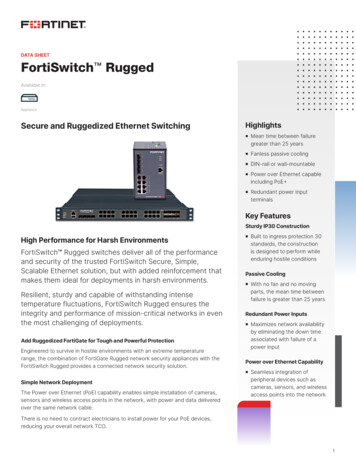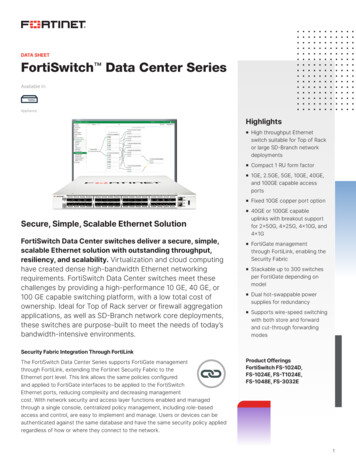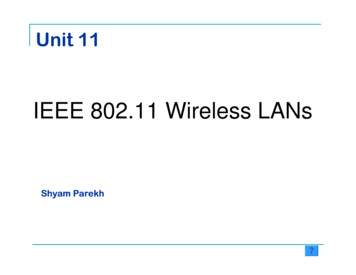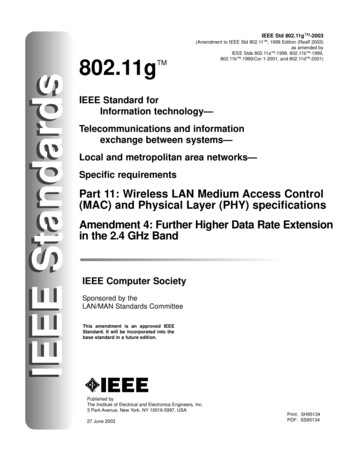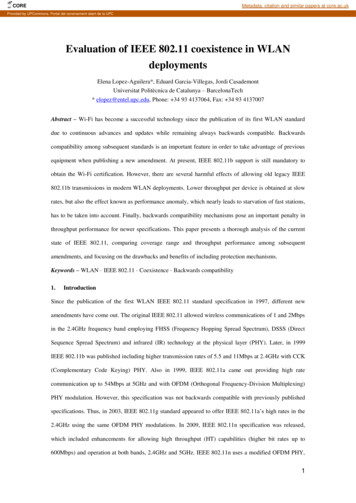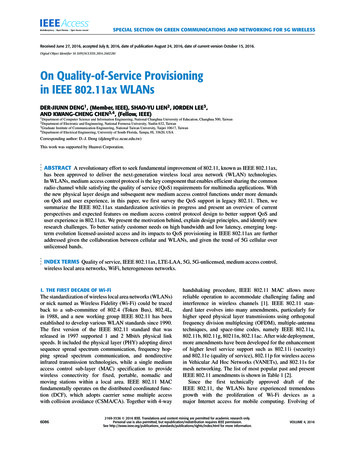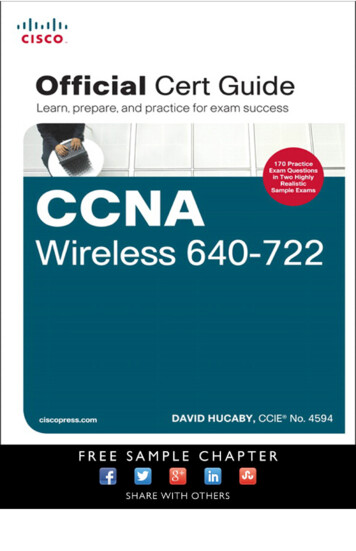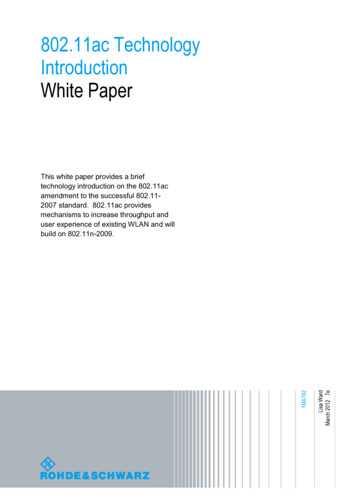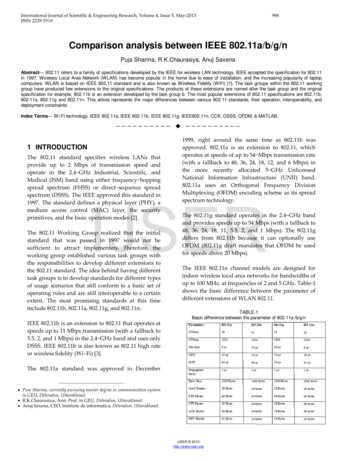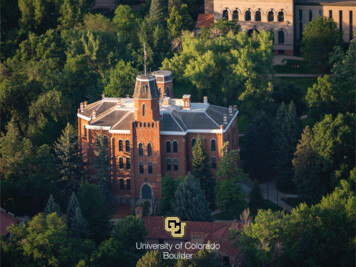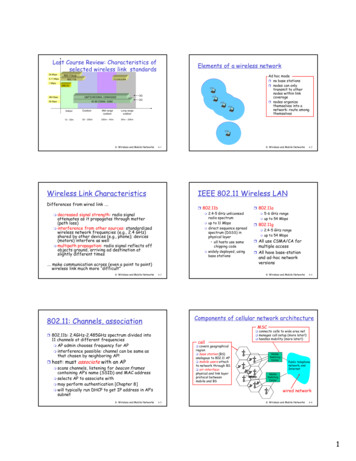
Transcription
Last Course Review: Characteristics ofselected wireless link standards54 Mbps5-11 MbpsElements of a wireless networkAd hoc mode no base stations nodes can onlytransmit to othernodes within linkcoverage nodes organizethemselves into anetwork: route amongthemselves802.11{a,g}802.11b.11 p-to-p link1 Mbps802.153GUMTS/WCDMA, CDMA2000384 Kbps2GIS-95 CDMA, GSM56 KbpsIndoorOutdoorMid rangeoutdoorLong rangeoutdoor10 – 30m50 – 200m200m – 4Km5Km – 20Km6: Wireless and Mobile Networks6: Wireless and Mobile Networks6-1Wireless Link CharacteristicsIEEE 802.11 Wireless LANDifferences from wired link . 802.11b 2.4-5 GHz unlicensedradio spectrum up to 11 Mbps direct sequence spreadspectrum (DSSS) inphysical layer all hosts use samechipping code widely deployed, usingbase stationsdecreased signal strength: radio signalattenuates as it propagates through matter(path loss) interference from other sources: standardizedwirelesslnetworkk frequenciesf((e.g., 2.44 GHGHz))shared by other devices (e.g., phone); devices(motors) interfere as well multipath propagation: radio signal reflects offobjects ground, arriving ad destination atslightly different times . make communication across (even a point to point)wireless link much more “difficult”6: Wireless and Mobile Networks 802.11a 5-6 GHz range up to 54 Mbps 802.11g 2.4-52 4-5 GHz range up to 54 Mbps All use CSMA/CA formultiple access All have base-stationand ad-hoc networkversions6: Wireless and Mobile Networks6-36-4Components of cellular network architecture802.11: Channels, associationMSC 802.11b: 2.4GHz-2.485GHz spectrum divided into11 channels at different frequencies AP admin chooses frequency for AP interference possible: channel can be same asy neighboringgg AP!that chosen bycell connects cells to wide area net manages call setup (more later!) handles mobility (more later!) covers geographicalregionbase station (BS)analogous to 802802.1111 AP mobile users attachto network through BS host: must associate with an AP scans channels, listening for beacon framescontaining AP’s name (SSID) and MAC address selects AP to associate with may perform authentication [Chapter 8] will typically run DHCP to get IP address in AP’ssubnet6: Wireless and Mobile Networks6-2 MobileSwitchinggCenterair-interface:physical and link layerprotocol betweenmobile and BSPublic telephonenetwork, andInternetMobileSwitchingCenterwired network6-56: Wireless and Mobile Networks6-61
What is mobility? spectrum of mobility, from theMobility via Indirect Routingnetwork perspective:no mobilitymobile wireless user, mobile user,using same accessconnecting/pointdisconnectingfrom networkusing DHCP.high mobilityhomenetwork3correspondentaddresses packetsusing home addressof mobilephone)214mobile repliesdirectly tocorrespondent6: Wireless and Mobile Networks6-7Indirect Routing: commentspermanent address: used by correspondent (hencemobile location is transparent to correspondent) care-of-address: used by home agent to forwarddatagrams to mobile foreign agent functions may be done by mobile itself triangle routing: correspondent-home-networkmobile inefficient whencorrespondent, mobileare in same networkcorrespondent forwardsto foreign agent foreign agentreceives packets,forwards to mobilehomenetworkvisitednetwork4wide areanetwork2341correspondentrequests, receivesforeign address ofmobilemobile repliesdirectly tocorrespondent6: Wireless and Mobile Networks6-96-10Mobile IP: indirect routingMobility via Direct Routing: comments overcome triangle routing problemforeign-agent-to-mobile packet non-transparent to correspondent:packet sent by home agent to foreignagent: a packet within a packetcorrespondent must get care-of-addressfrom home agent 6-8Mobility via Direct Routing Mobile uses two addresses:6: Wireless and Mobile Networksvisitednetworkwide areanetworkmobile user, passingthrough multipleaccess point whilemaintaining ongoingconnections (like cell6: Wireless and Mobile Networksforeign agentreceives packets,forwards to mobilehome agent interceptspackets, forwards toforeign agentdest: 79.129.13.2dest: 128.119.40.186dest: 128.119.40.186what if mobile changes visited network?Permanent address:128.119.40.186dest: 128.119.40.186Care-of address:79.129.13.2packet sent bycorrespondent6: Wireless and Mobile Networks6-116: Wireless and Mobile Networks6-122
Components of cellular network architecturehome network: network of cellular provider yousubscribe to (e.g., Sprint PCS, Verizon) home location register (HLR): database in homenetwork containing permanent cell phone #,profile information (services, preferences,billi ) informationbilling),i fti aboutb t currentt llocationti(could be in another network) visited network: network in which mobile currentlyresides visitor location register (VLR): database withentry for each user currently in network could be home network recall:correspondentwired publictelephonenetworkMSCMSCMSCMSCMSCdifferent cellular networks,operated by different providers6: Wireless and Mobile NetworkshomenetworkHLR2home MSC consults HLR,gets roaming number ofmobile in visited network Handoff goal: route call ngold BSS new BSSVLR MobileSwitchingCenter 2473new BSS stronger signal to/from newBSS (continuing connectivity,connectivityless battery drain)load balance: free up channelin current BSSGSM doesn’t mandate why toperform handoff (policy), onlyhow (mechanism) handoff initiated by old BSS6-16GSM: handoff between MSCs1. old BSS informs MSC of impendinghandoff, provides list of 1 new BSSs2. MSC sets up path (allocates resources)to new BSS3. new BSS allocates radio channel foruse by mobile4. new BSS signals MSC, old BSS: ready5. old BSS tells mobile: perform handoff tonew BSS6. mobile, new BSS signal to activate newchannel7. mobile signals via new BSS to MSC:handoff complete. MSC reroutes call8 MSC-old-BSS resources released6: Wireless and Mobile Networks6: Wireless and Mobile Networks6-15GSM: handoff with common MSC6 MSC in visited network completescall through base station to mobile6: Wireless and Mobile Networks5SwitchingCentercall routedto home networkhome MSC sets up 2nd leg of callto MSC in visited networkmobileuserold BSSnew base station (withoutinterruption) reasons for handoff:VLR Mobile3VLR6-14GSM: handoff with common MSChomeMobileSwitchingCenter186: Wireless and Mobile Networks6-13GSM: indirect routing to mobile1Handling mobility in cellular networks6-17 home networkcorrespondentHomeMSCanchor MSC: first MSCvisited during cal call remains routedthrough anchor MSC new MSCs add on to endanchor MSCPSTNMSCMSCMSC(a) before handoffof MSC chain as mobilemoves to new MSC IS-41 allows optionalpath minimization stepto shorten multi-MSCchain6: Wireless and Mobile Networks6-183
Mobility: GSM versus Mobile IPGSM: handoff between MSCs home networkcorrespondentHomeMSCGSM elementanchor MSC: first MSCvisited during cal call remains routedthrough anchor MSC new MSCs add on to endanchor MSCPSTNMSCMSCMSC(b) after handoffof MSC chain as mobilemoves to new MSC IS-41 allows optionalpath minimization stepto shorten multi-MSCchain6: Wireless and Mobile Networksshould be minimal best effort service model remains unchanged TCP and UDP can (and do) run over wireless, mobile but performance-wise: packet loss/delay due to bit-errors (discardedpackets, delays for link-layer retransmissions), andhandoff TCP interprets loss as congestion, will decreasecongestion window un-necessarily delay impairments for real-time traffic limited bandwidth of wireless links logically, impact Home networkGateway MobileSwitching Center, or“home MSC”. HomeLocation Register(HLR)Home MSC: point of contact to obtain routableaddress of mobile user. HLR: database inhome system containing permanent phonenumber, profile information, current location ofmobile user, subscription informationHome agentVisited SystemNetwork other than home system wheremobile user is currently residingVisited networkVisited Mobileservices SwitchingCenter.Visitor LocationRecord (VLR)Visited MSC: responsible for setting up callsto/from mobile nodes in cells associated withMSC. VLR: temporary database entry invisited system, containing subscriptioninformation for each visiting mobile userForeign agentMobile StationRoaming Number(MSRN), or “roamingnumber”Routable address for telephone call segmentbetween home MSC and visited MSC, visibleto neither the mobile nor the correspondent.Care-ofaddress6: Wireless and Mobile Networks6-20Chapter 6 SummaryWireless wireless links: capacity, distancechannel impairmentsCDMA IEEE 802.11 (“wi-fi”) CSMA/CA reflectswireless channelcharacteristics cellular access architecture standards (e.g., GSM,CDMA-2000, UMTS)Mobility principles: addressing,routing to mobile users home, visited networksdirect, indirect routingcare-of-addresses case studies mobile IP mobility in GSM impact on higher-layerprotocols6: Wireless and Mobile Networks6-21Multimedia, Quality of Service:What is it?Mobile IP elementNetwork to which the mobile user’s permanentphone number belongs6-19Wireless, mobility: impact on higher layer protocols6: Wireless and Mobile NetworksComment on GSM elementHome system6-22Chapter 7: GoalsMultimedia applications:network audio and video(“continuous media”)Principles Classify multimedia applications Identify the network services the appsneed Making the best of best effort service Mechanisms for providing QoSQoSnetwork providesapplication with level ofProtocols and Architectures Specific protocols for best-effort Architectures for QoSperformance needed forapplication to function.6: Wireless and Mobile Networks6-236: Wireless and Mobile Networks6-244
Chapter 7 outline 7.1 Multimedia Networking Applications7.2 Streaming storedaudio and video7.3 Real-time Multimedia:Internet Phone study7.4 Protocols for RealTime InteractiveApplications RTP,RTCP,SIP7.5 DistributingMultimedia: contentdistribution networksMM Networking Applications 7.6 Beyond BestClasses of MM applications:1) Streaming stored audioand video2) Streaming live audio andvideo3) Real-time interactiveaudio and videoEffort 7.7 Scheduling andPolicing Mechanisms 7.8 IntegratedServices andDifferentiatedServices 7.9 RSVPJitter is the variabilityof packet delays withinthe same packet stream6: Wireless and Mobile Networks1. videorecorded2. video2sentnetworkdelay3. video received,played out at clienttimestreaming: at this time, client timing constraint for still-to-beplaying out early part of video,while server still sending laterpart of videotransmitted data: in time for playout6-27Streaming Stored Multimedia:Interactivity6: Wireless and Mobile Networks6-28Streaming Live MultimediaExamples: Internet radio talk show Live sporting eventStreaming playback buffer playback can lag tens of seconds aftertransmission still have timing constraintInteractivity fast forward impossible rewind, pause possible!VCR-like functionality: client canpause, rewind, FF, push slider bar 10 sec initial delay OK 1-2 sec until command effect OK RTSP often used (more later) timing constraint for still-to-betransmitted data: in time for playout6: Wireless and Mobile Networks6-26Streaming Stored Multimedia:What is it?Streaming: media stored at source transmitted to client streaming: client playout beginsbefore all data has arrived 6: Wireless and Mobile Networks6-25Streaming Stored Multimedia6: Wireless and Mobile NetworksFundamentalcharacteristics: Typically delay sensitive end-to-end delay delay jitter But loss tolerant:infrequent losses causeminor glitches Antithesis of data,which are loss intolerantbut delay tolerant.6-296: Wireless and Mobile Networks6-305
Interactive, Real-TimeMultimediaMultimedia Over Today’sInternetTCP/UDP/IP: “best-effort service” applications: IP telephony, no guarantees on delay, lossvideo conference, distributedinteractive worlds endend-endend delay requirements: audio: 150 msec good, 400 msec OK includes application-level (packetization) andnetwork delays higher delays noticeable, impair interactivity session initialization how does callee advertise its IP address, portnumber, encoding algorithms?6: Wireless and Mobile Networks?images displayed atconstant rate e.g. 24 images/sec Digital image isarray of pixels Each pixelrepresented by bits Redundancy6-32A few words about audiocompression Analog signal sampled atconstant rate telephone: 8,000samples/sec CD music: 44,100samples/sec Each sample quantized, i.e.,rounded e.g., 28 256 possiblequantized values Each quantized valuerepresented by bits 8 bits for 256 valuesWhat’s your opinion? Example: 8,000samples/sec, 256 quantizedvalues -- 64,000 bps Receiver converts it backto analog signal: some quality reductionExample rates CD: 1.411 Mbps MP3: 96, 128, 160 kbps Internet telephony: 5.3 13 kbps6: Wireless and Mobile Networks6-336-34Chapter 7 outlineExamples: MPEG 1 (CD-ROM) 1.5Mbps MPEG2 (DVD) 3-6 Mbps MPEG4 (often used inInternet, 1 Mbps)Research: Layered (scalable) video adapt layers toavailable bandwidth 7.1 Multimedia 7.6 Beyond Best 7.7 Scheduling and spatial temporal 6: Wireless and Mobile Networks?6: Wireless and Mobile Networks6-31A few words about videocompression Video is sequence of?Today’s Internet multimedia applicationsuse application-level techniques to mitigate(as best possible) effects of delay, lossDifferentiated servicesphilosophy: Fewer changes toInternetinfrastructure yetinfrastructure,provide 1st and 2ndclass service.6: Wireless and Mobile Networks?How should the Internet evolve tobetter support multimedia?Integrated services philosophy: Fundamental changes inInternet so that apps canreserve end-to-endbandwidth Requires new, complexsoftwareftiin hhostst & routerstLaissez-faire no major changes more bandwidth whenneeded content distribution,application-layer multicast application layer?But you said multimedia apps requires ?Q S andQoSd llevell off performanceftto bbe? effective!?6-35Networking Applications7.2 Streaming storedaudio and video7.3 Real-time Multimedia:Internet Phone study7.4 Protocols for RealTime InteractiveApplications RTP,RTCP,SIP7.5 DistributingMultimedia: contentdistribution networksEffortPolicing Mechanisms 7.8 IntegratedServices andDifferentiatedServices 7.9 RSVP6: Wireless and Mobile Networks6-366
Internet multimedia: simplestapproachStreaming Stored MultimediaApplication-levelstreaming techniquesfor making the bestout of best effortservice: client sidebuffering use of UDP versusTCP multiple encodingsof multimediaMedia Player jitter removal audio or video stored in file decompression files transferred as HTTP error concealmentobject received in entirety atclient then passed to playeraudio, video not streamed: no, “pipelining,” long delays until playout! graphical userinterfacew/ controls forinteractivity6: Wireless and Mobile NetworksInternet multimedia: streamingapproach This architecture allows for non-HTTP protocol browser launches player, passing metafilebetween server and media player player contacts server Can also use UDP instead of TCP.6: Wireless and Mobile Networksconstant bitrate videoplayout at clientclient playoutdelay Client-side buffering, playout delay6-40Streaming Multimedia: ClientBufferingconstantdrainrate, dvariable fillrate, x(t)buffeeredvideovariablenetworkd ldelayclient videoreception6: Wireless and Mobile Networks6-39Streaming Multimedia: ClientBufferingconstant bitrate videotransmission6-38Streaming from a streamingserver browser GETs metafile server streams audio/video to player6: Wireless and Mobile Networks6-37timecompensate for network-added delay, delayjitter6: Wireless and Mobile Networks 6-41bufferedvideo Client-side buffering, playout delaycompensate for network-added delay, delayjitter6: Wireless and Mobile Networks 6-427
Streaming Multimedia: UDP orTCP?Streaming Multimedia: clientrate(s)1.5 Mbps encodingUDP server sends at rate appropriate for client (oblivious tonetwork congestion !) often send rate encoding rate constant rate then, fill rate constant rate - packet loss short playout delay (2-5(2 5 seconds) to compensate for networkdelay jitter error recover: time permittingTCP send at maximum possible rate under TCP fill rate fluctuates due to TCP congestion control larger playout delay: smooth TCP delivery rate HTTP/TCP passes more easily through firewalls6: Wireless and Mobile Networks28.8 Kbps encodingQ: how to handle different client receive ratecapabilities? 28.8 Kbps dialup 100Mbps EthernetA: server stores, transmits multiple copiesof video, encoded at different ratesUser Control of StreamingMedia: RTSPHTTP Does not target multimediacontent No commands for fastforward, etc.RTSP RFC 2326RTSP: Client-server applicationlayer protocol. For user to control display:rewind, fast forward,pause, resume,repositioning, etc 6-44RTSP: out of band controlFTP uses an “out-of-band”control channel: A file is transferred overone TCP connection. Control information(directory changes, filef renaming,m g,deletion,, fileetc.) is sent over aseparate TCP connection. The “out-of-band” and “inband” channels usedifferent port numbers.What it doesn’t do: does not define howaudio/video is encapsulatedfor streaming over network does not restrict howstreamed media isttransported;t d it can bbetransported over UDP orTCP does not specify how themedia player buffersaudio/video6: Wireless and Mobile Networks6: Wireless and Mobile Networks6-43RTSP messages are alsosent out-of-band: RTSP controlmessages usedifferent portnumbers than themedia stream: out-ofband. Port 554 The media stream isconsidered “in-band”.6: Wireless and Mobile Networks6-456-46RTSP ExampleMetafile ExampleScenario: title Twister /title session group language en lipsync switch track type audioe "PCMU/8000/1"src "rtsp://audio.example.com/twister/audio.en/lofi" " t // dil/t i t / di/l fi" track type audioe "DVI4/16000/2" pt "90 DVI4/8000/1"src "rtsp://audio.example.com/twister/audio.en/hifi" /switch track type "video/jpeg"src "rtsp://video.example.com/twister/video" /group /session metafile communicated to web browser browser launches player player sets up an RTSP control connection,data connection to streaming server6: Wireless and Mobile Networks6-476: Wireless and Mobile Networks6-488
IEEE 802.11 Wireless LAN 802.11b 2.4-5 GHz unlicensed radio spectrum up to 11 Mbps direct sequence spread 802.11a 5-6 GHz range up to 54 Mbps 802.11g 24-5 GHz range 6: Wireless and Mobile Networks6-4 spectrum (DSSS) in physical layer all hosts use same chipping co

